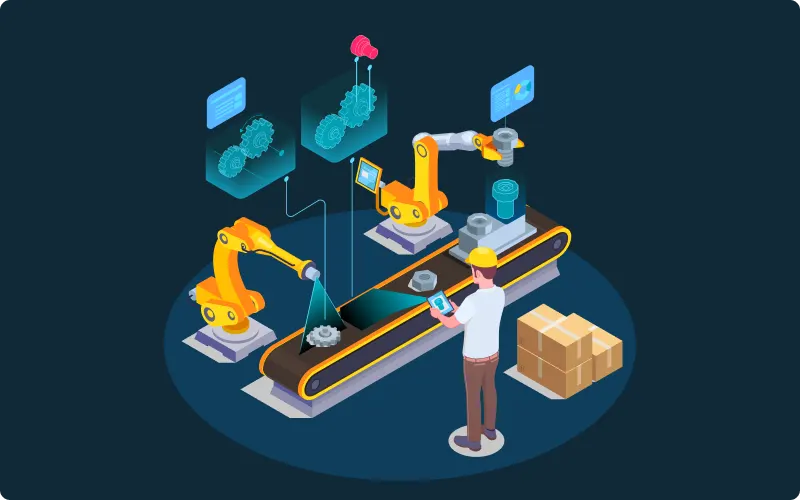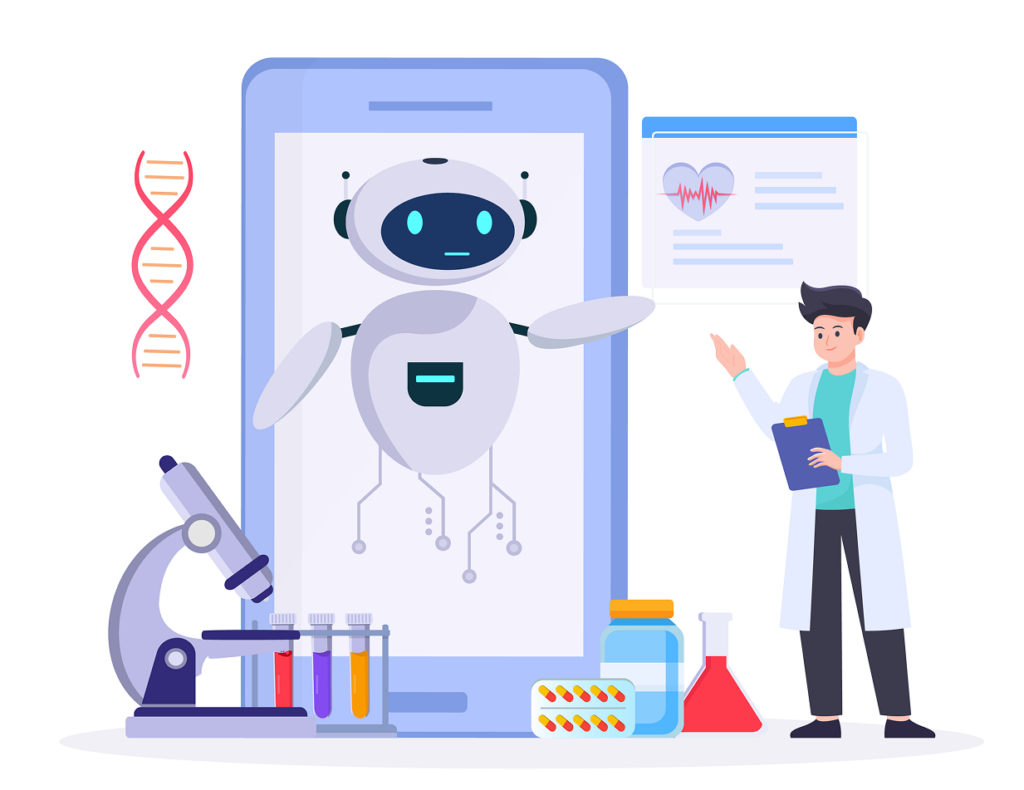AI in product lifecycle management: Applications, industry use cases, technologies and development
In the dynamic intersection of technology and product management lies the transformative potential of Artificial Intelligence (AI). AI has transformed Product Lifecycle Management (PLCM/PLM), introducing a wave of innovation that is profoundly reshaping product development processes. Amidst a landscape abundant in technological advancements such as generative AI and data engineering, PLM has evolved to meet the rising tide of customer expectations for more personalized and immersive experiences. Contact Us
AI’s role in PLM is multi-dimensional, bridging various domains, including engineering, design, marketing, and strategy, to create products that resonate with customer needs and market relevance. It has empowered product managers with tools for predictive analytics, intelligent automation, and enhanced customer insights, thereby cultivating a culture of continuous innovation and improvement.
Research spearheaded by industry leaders like McKinsey explains the pivotal role of robust product management in driving commendable business performance and delivering unparalleled customer value across diverse sectors. Modern product managers, armed with AI, navigate through the complexities of evolving technological landscapes with strategic precision. They harness the power of AI to enhance decision-making processes, embracing a holistic approach that seamlessly integrates technology with customer-centric strategies. AI facilitates an environment where product managers can employ human-centric designs, coupled with technological acumen, to align products more closely with business objectives and customer expectations.

What is product lifecycle management (PLCM)?
Product Lifecycle Management (PLM) stands as a monumental discipline in the enterprise arena, elegantly conducting the symphony of data and processes that breathes life into a product’s journey. From the nascent whispers of inception through the harmonized stages of engineering, design, manufacture, and eventual retirement, PLM orchestrates a meticulous composition. In more technical terms, Product Lifecycle Management (PLM) is a comprehensive process that allows manufacturers and their supply chain partners to meticulously manage and coordinate all data and processes related to a product, from its inception through design, development, and production stages. This incorporates a multitude of elements such as drawings, specifications, documentation, and bills of materials (BOMs), among others.
Historical prelude: The genesis at American Motors Corporation (AMC) The history of PLM began with a burst of innovation at American Motors Corporation (AMC), where it played a crucial role in the speedy and efficient development of vehicles like the Jeep Grand Cherokee. From the start, PLM used advanced tools like computer-aided design (CAD) and a centralized system for managing product data, making it easier to organize and store important documents and drawings in one place. This new approach improved communication and collaboration, reducing the need for changes in the engineering process. After Chrysler acquired AMC, they continued to improve on this system, making the development process even more efficient.

New Product Development (NPD) phases
- Development phaseAt this stage, the focus is on specification, design, and prototyping. Activities are aimed at ensuring the product resonates with market needs and expectations. Prototype designs undergo various iterations and refinements based on market research and technical inputs to meet all essential requirements.
- Limited production phaseThis stage aims to evaluate the product design’s manufacturability. Efforts are directed towards ensuring that components are readily sourceable and customized parts can be manufactured as per requirements. The emphasis is also on ensuring that the supply chain can deliver products aligning with the organization’s quality objectives.
- Full production phaseHere, the primary goal is high-volume product manufacturing at competitive costs while continuously evaluating avenues for cost-optimization without compromising product quality.

Stages of the product lifecycle
This initial stage involves launching the product in the market, where significant investments are made in marketing activities to build product awareness and stimulate consumer interest.
- GrowthIn this phase, there is an elevation in product demand, production, and availability. The product experiences an upward trajectory in market adoption.
- MaturityThis stage is characterized by optimum profitability, as expenses associated with marketing and production are generally reduced, and the product has established its market presence.
- DeclineEventually, the product enters a phase of decline, where it experiences a reduction in market share due to factors such as increased competition and market saturation.
Different stages of PLCM and how AI can improve the processes in each stage
In the early stages of developing a new product or idea, innovation is nurtured with careful consideration. This step involves closely examining market trends, understanding the competition, and identifying new opportunities or ‘gaps’ that can be explored creatively. Instead of relying on traditional methods like simple social media monitoring and manual analysis, this approach uses Artificial Intelligence (AI) to add an extra layer of guidance known as AI-driven product intelligence.

Ideation stage and AI in PLCM
In the ideation stage of developing a new product, AI plays a critical role in nurturing innovation. AI-driven product intelligence analyzes market trends, competition, and new opportunities more deeply than traditional methods. By leveraging AI, organizations can understand real-time market needs, ensuring that new products align perfectly with customer requirements. This AI application not only improves current offerings but also sets the stage for future organizational success.In the design face, PLM brings together various capabilities simultaneously. It coordinates different areas like design, engineering, simulation, and marketing, allowing them to work together smoothly and improve continuously. In this setup, design and engineering can quickly adapt and make changes as they go through testing and improvement processes.
This flexibility speeds up the process of turning initial ideas into finished products, making it quicker to enter the market and start making profits. Companies find powerful ways to improve their product development in this well-organized system, leading to better innovation and increased profits. In short, PLM helps companies fill the market with innovative products that meet customer needs and market demands quickly and efficiently.

Design stage and AI in PLCM
During the design phase, AI in PLM facilitates coordination across design, engineering, simulation, and marketing. AI enhances flexibility in the design and engineering process, allowing for rapid adaptations and improvements. This integration speeds up the process of transforming initial ideas into market-ready products, improving innovation and profitability.
BOM management and AI in PLCM
In BOM management, AI enriches the core of PLM by linking product definitions, manufacturing details, source materials, documentation, and pricing. AI helps manage this extensive range of aspects efficiently, fostering collaboration between engineering, design, strategic planning, and market strategies. Improved collaboration and accuracy, often supported by AI-integrated CAD systems, accelerate product development and market introduction.Engineer-to-order (ETO) is a specific approach within PLM where customers play a key role in defining and designing a product. It’s a two-way creative process involving both customers and the company.
ETO and PLM together provide a secure, unified platform that easily allows access to essential information like sales, engineering, and operational strategies. This makes the process of reviewing, designing, and delivering products smoother. The platform isn’t just for engineers; it also encourages collaboration with partners, suppliers, and customers.
ETO is adaptable and strategic, navigating through market competition and changing customer needs. Modern PLM, supported by cloud technology, helps manage and coordinate various aspects like engineering, strategic planning, and customer requests, aligning with the ETO approach.
By collecting and using information from partners, suppliers, and customers, PLM supports the ETO process, improving customer service, quote accuracy, employee productivity, and the overall product development and delivery process. ETO, supported by PLM, aims to enhance customer satisfaction and product success.

The engineer-to-order approach and AI in PLCM
In the ETO approach, AI-enabled PLM platforms facilitate a collaborative process involving customers, engineers, partners, and suppliers. AI supports managing and coordinating sales, engineering, and operational strategies on these platforms, enhancing the ETO process. This leads to improved customer service, accurate quotes, and better product development and delivery.- Change management: This involves managing various changes that occur during the life of a product, from its creation, design, and manufacturing to its actual use. Change management ensures that all updates, modifications, and terminations are well-organized and documented. This helps maintain clear communication between different parts of an organization and external partners.
- Cost management: This area focuses on controlling and tracking the costs related to the tools and components used in product development. Having a clear understanding of all costs is essential for profitability. With the help of modern PLM software, cost management can identify areas where costs can be reduced or controlled more effectively, ensuring that resources are used efficiently.

Production stage and AI in PLCM
AI significantly contributes to the production stage in PLM, focusing on change management, cost control, and supplier qualification. AI streamlines change management by organizing updates and modifications efficiently. It also aids in cost management by identifying areas for cost reduction and better resource utilization, ensuring profitability.- Product information management: PIM helps organizations distribute their products through different sales channels like direct sales, distributors, and e-commerce platforms. It ensures that detailed and accurate product information is consistently shared across all these channels.
- Integration of PIM and PLM: When PIM and PLM work together, they create a central source of detailed product data. This integration helps coordinate various areas such as sales, marketing, engineering, and manufacturing, ensuring a cohesive organizational approach.
- Creating market-ready products: PIM plays a vital role in preparing products for the market. It helps organize product details, manage stock-keeping units (SKUs), and set appropriate pricing.
- Marketing and quality management: PIM also aids in marketing efforts, helping create detailed product manuals, attractive images, and compelling content for distributor platforms and e-commerce websites. Quality Management Systems (QMS) ensure that products meet certain standards and adapt based on customer feedback and insights.

Distribution and service excellence with AI in PLCM
AI plays a vital role in managing distribution and service. Integrating AI with PIM within PLM ensures effective product transition from manufacturing to market. AI enhances the coordination of sales, marketing, engineering, and manufacturing efforts, making products market-ready. AI also supports marketing and quality management, ensuring products meet standards and adapt based on customer feedback.Applications of AI in PLCM
Artificial Intelligence has transformative influences on Product Lifecycle Management, heralding an era of innovation and strategic enhancement in technological development and tool utilization. AI unfurls its powerful potential to revitalize various dimensions of product development, fostering enhanced decision-making and strategic support across design, manufacturing, customer assistance, and project maintenance spheres.

Cultivating requirements management and traceability
Navigating the critical pathways of requirements management, AI emerges as a beacon of analytical proficiency. Through leveraging Natural Language Processing and adept synthesis of expansive data realms encompassing documents, videos, and diverse information caches, AI fosters groundbreaking advancements in tools dedicated to requirements management and validation within PLM software landscapes.

Harnessing the power of data reusability
AI improves efficiency in product development by promoting the reuse of existing data. Through AI’s meticulous analysis, unveiling patterns and interrelations within vast data territories, organizations are empowered to repurpose existing components, curtailing redundancy and optimizing cost-effectiveness strategically. AI thus emerges as a catalyst for informed decision-making, enriching New Product Development (NPD) processes with historical insights and configurational finesse.

Elevating virtual assistance and customer interaction
AI improves various areas that require human involvement, bringing better organization and new, efficient working methods. It helps create virtual assistants that can handle tasks, plan meetings, and manage approval processes more smoothly. In maintenance and customer support, AI provides smart help, improving interactions and overall performance.

Redefining user experience dynamics
AI heralds a transformative impact on the user experience (UX) paradigms within PLM systems, answering the strong demand for simplification and enhanced usability. It unfolds innovative horizons, reimagining user interfaces through conversational engagements, speech recognition, and diverse modalities, thereby nurturing a garden of user-centric enhancements and functional simplicity.

Nurturing planning intelligence
AI emerges as the architect of planning intelligence within PLM, nurturing landscapes where strategic visions flourish amidst data-driven insights and analytical prowess. AI’s use of machine learning navigates the complexities of configurations, supply landscapes, and portfolio intricacies, unveiling optimized pathways in product design and supplier engagements. Thus, AI fosters a vibrant ecosystem where engineering visions are harmonized with emerging opportunities, enabling organizations to soar on the wings of competitive foresight and strategic agility.
Optimizing product lifecycle management workflow using GenAI
Product lifecycle management (PLM) is a crucial process for organizations, encompassing the planning, development, launch, and end-of-life stages of a product. Traditional PLM can be challenging, requiring coordination across multiple departments and the handling of vast amounts of data. Generative AI offers transformative capabilities to streamline and optimize the entire product lifecycle, enhancing efficiency, accuracy, and collaboration at every stage.
Historical prelude: The genesis at American Motors Corporation (AMC) The history of PLM began with a burst of innovation at American Motors Corporation (AMC), where it played a crucial role in the speedy and efficient development of vehicles like the Jeep Grand Cherokee. From the start, PLM used advanced tools like computer-aided design (CAD) and a centralized system for managing product data, making it easier to organize and store important documents and drawings in one place. This new approach improved communication and collaboration, reducing the need for changes in the engineering process. After Chrysler acquired AMC, they continued to improve on this system, making the development process even more efficient.

Key personas involved in the PLM workflow
The product manager: Utilizes GenAI to generate product requirement drafts, analyze market trends, and optimize decision-making throughout the product lifecycle.
The manufacturing engineer: Uses GenAI to identify process inefficiencies, suggest automation opportunities, and enhance manufacturing workflows for optimal production efficiency.
The regulatory compliance officer: Applies GenAI to streamline regulatory research, draft compliance documentation, and ensure adherence to industry standards throughout the product lifecycle.
The supply chain manager: Employs GenAI to forecast inventory needs, optimize supply chain logistics, and ensure timely delivery of components across the product lifecycle.
Here’s how generative AI enhances each stage of product lifecycle management workflow:
| Steps Involved | Sub-Steps | Role of generative AI |
|---|---|---|
| Brainstorming |
|
|
| Concept development |
|
|
| Feasibility analysis |
|
|
| Documentation |
|
|
| Steps Involved | Sub-Steps | Role of generative AI |
|---|---|---|
| Engineering and design |
|
|
| Testing and validation |
|
|
| Collaboration |
|
|
| Steps Involved | Sub-Steps | Role of generative AI |
|---|---|---|
| Production planning |
|
|
| Manufacturing execution |
|
|
| Quality assurance |
|
|
| Steps Involved | Sub-Steps | Role of generative AI |
|---|---|---|
| Product launch |
|
|
| Customer feedback |
|
|
| Support and maintenance |
|
|
| End-of-life planning |
|
|
The role of AI in product development lifecycle management in different industries
Here’s a detailed breakdown of how AI is applied across the various stages of product development lifecycle within different industries:
| PLCM stage | Application |
|---|---|
| Conceptualization and planning |
|
| Design and development |
|
| Prototype and testing |
|
| Production and manufacturing |
|
| PLCM stage | Application |
|---|---|
| Conceptualization and planning |
|
| Design and development |
|
| Prototype and testing |
|
| Production and manufacturing |
|
| PLCM stage | Application |
|---|---|
| Conceptualization and planning |
|
| Design and development |
|
| Prototype and testing |
|
| Production and manufacturing |
|
| PLCM stage | Application |
|---|---|
| Conceptualization and planning |
|
| Design and development |
|
| Prototype and testing |
|
| Production and manufacturing |
|
| PLCM stage | Application |
|---|---|
| Conceptualization and planning |
|
| Design and development |
|
| Prototype and testing |
|
| Production and manufacturing |
|
| PLCM stage | Application |
|---|---|
| Conceptualization and planning |
|
| Design and development |
|
| Prototype and testing |
|
| Production and manufacturing |
|
| PLCM stage | Application |
|---|---|
| Conceptualization and planning |
|
| Design and development |
|
| Prototype and testing |
|
| Production and manufacturing |
|
| Distribution and Service |
|
| Customer feedback and improvement |
|
Comprehensive enterprise services & support
How does DeepSurge’s generative AI platform transform product lifecycle management processes?
DeepSurge’s AI development services for product lifecycle management
At DeepSurge, we specialize in developing AI solutions that cater to the unique requirements of product lifecycle management (PLM). Our strategic AI/ML consulting enables companies to harness AI for enhanced decision-making, improved product development, and optimized manufacturing strategies.
We excel in developing Proof of Concepts (PoCs) and Minimum Viable Products (MVPs) that allow firms to preview the potential impacts of AI tools in real scenarios, ensuring that the solutions are effective and tailored to the specific needs of the product lifecycle.
Our expertise in generative AI transforms routine tasks like report generation and data management, automating these processes to free up professionals for more strategic roles.
By fine-tuning large language models to the nuances of product terminology and customer interactions, LeewayHertz enhances the accuracy and relevance of AI-driven communications and analyses in the context of product development and management.
Additionally, we ensure that our AI systems integrate seamlessly with existing technological infrastructures, enhancing operational efficiency and decision-making throughout the product life cycle.

Our AI solutions development expertise
AI solutions development for product lifecycle management typically involves creating systems that enhance decision-making, automate routine tasks, and personalize product services. These solutions integrate key components such as data aggregation technologies, which compile and analyze product information from diverse sources. This comprehensive data foundation supports predictive analytics capabilities, allowing for the forecasting of market trends that inform strategic decisions. Additionally, machine learning algorithms are employed to tailor product strategies to individual customer profiles, ensuring that each customer’s unique needs and preferences are considered. These solutions often cover areas like product development, production planning, quality control, supply chain management, and customer relationship management.
Overall, AI solutions in product lifecycle management aim to optimize product outcomes, improve efficiency, and enhance the customer experience.

AI agent/copilot development for product lifecycle management
DeepSurge builds custom AI agents and copilots that enhance various product lifecycle management operations, enabling companies to save time and resources while facilitating faster decision-making. Here is how they help:
Product analysis
- Performing data analysis and generating reports on product performance and market trends.
- Identifying potential product improvements or new product opportunities based on predefined criteria or rules.
- Analyzing historical and real-time data to predict future product demand and market movements.
Client engagement
- Analyzing client data and past interactions to provide personalized product recommendations and customer support.
- Automating communication tasks like product updates and customer inquiries.
- Offering 24/7 virtual assistance to answer customer queries and provide product information.
Compliance and risk monitoring
- Automating regulatory document analysis, ensuring compliance with product regulations and standards.
- Monitoring product compliance with predefined rules and quality policies.
- Automating documentation and reporting processes.
- Flagging any potential compliance violations or product quality discrepancies.
Process automation
- Automating repetitive tasks such as data entry and report generation.
- Automating data validation and verification tasks.
- Automating product development and launch processes.
Asset management
- Recommending asset management strategies based on predefined models or rules.
- Identifying asset maintenance needs and suggesting actions within defined thresholds.
Resource management
- Gathering and analyzing data from diverse sources, providing product managers with a holistic view of resource allocation and utilization.
- Customizing resource plans based on product requirements and resource availability, ensuring efficient resource allocation.
- Providing real-time insights into product conditions and resource performance, supporting timely and informed decision-making.
Risk mitigation
- Monitoring product activities for predefined patterns or rules associated with potential risks.
- Flagging potential risks based on predefined criteria or models.
Customer segmentation and targeting
- Analyzing customer data to segment customers based on predefined criteria (e.g., demographics, buying behavior, product preferences).
- Identifying potential opportunities for product customization or targeted marketing based on customer segments.
AI technologies used in PLCM
Artificial Intelligence has a transformative impact on Product Lifecycle Management PLM, influencing various stages from conception to obsolescence. Several AI technologies and techniques are pertinent in enhancing and transforming the processes involved in PLM:
Machine Learning (ML)
- Predictive analytics: ML enables predictive analytics by analyzing historical data to predict future trends, potential issues, or outcomes. This is particularly useful in product planning and design stages.
- Pattern recognition: ML can identify patterns and trends in data, which is valuable in making informed decisions throughout the product lifecycle.
Natural Language Processing (NLP)
- Requirements management: NLP can help in analyzing and synthesizing large sets of unstructured data like customer reviews and feedback to extract user needs and requirements.
- Documentation: Automatically generating and managing product documentation by processing and summarizing relevant information.
Robotic Process Automation (RPA)
- Workflow automation: Automating routine and repetitive tasks in the PLM process, such as data entry, thereby enhancing productivity.
- Change management: Automating the change management process to handle revisions, approvals, and other related tasks efficiently.
Computer vision
- Quality inspection: Using computer vision to automate the quality inspection processes in the manufacturing stage to ensure product standards.
- Design assistance: Assisting designers by converting visual concepts into detailed designs or schematics.
Recommendation systems
- Component reusability: Recommending existing components or materials that can be reused in new product developments to save costs and time.
- Supplier and material recommendation: Assisting in making informed decisions about suppliers and materials based on historical data and trends.
Simulation and optimization algorithms
- Product testing: Using algorithms to simulate product performance under various conditions to identify areas of improvement.
- Optimization: Optimizing product designs and processes for better performance and cost-effectiveness.
Knowledge graphs
- Data interlinking: Connecting related data to provide a comprehensive view of information relevant to the product lifecycle.
- Semantic search: Enhancing search capabilities within PLM systems for more relevant and contextual results.
Semantic search
Enhancing search capabilities within PLM systems for more relevant and contextual results.
Integrating these AI technologies within PLM processes fosters innovation, improves efficiency, and enhances decision-making across the product lifecycle. It allows organizations to be more responsive and adaptive to market needs and changes, ensuring the continual evolution and improvement of products.
Advantages of applying AI in product lifecycle management
Applying AI in product lifecycle management comes with a multitude of advantages that enhance the overall product development process and subsequent management stages. Here are the benefits detailed across different stages of the PLCM:
Ideation and planning
- Enhanced market analysis: AI can meticulously analyze market trends, consumer behaviors, and competitive landscapes to identify viable product opportunities and innovations.
- Improved forecasting: AI enhances predictive analytics, helping in better forecasting product viability and market demand and facilitating more informed decision-making.
Design and development
- Optimized design processes: AI can assist designers in making data-driven decisions, offering suggestions, identifying potential design flaws, and enhancing creativity through generative design.
- Material and process selection: AI can aid in choosing materials and processes that optimize product performance, sustainability, and cost-effectiveness.
Prototyping and testing
- Automated testing: AI can automate and optimize testing processes, identifying defects or areas of improvement with precision and speed.
- Predictive maintenance: AI predicts when equipment or prototypes may need maintenance or adjustments, minimizing downtime.
Manufacturing and production
- Smart manufacturing: AI facilitates intelligent automation and real-time monitoring of the manufacturing processes, enhancing productivity and quality.
- Inventory management: AI assists in managing and optimizing inventory levels, predicting demand, and improving supply chain efficiencies.
Distribution and service
- Supply Chain optimization: AI enhances logistics and distribution through route optimization, demand forecasting, and automated customer service.
- Service automation: AI can automate customer service processes, using chatbots or virtual assistants to improve customer interaction and problem resolution.
Feedback and improvement
- Customer feedback analysis: AI can analyze customer feedback and reviews across various platforms to garner insights into product performance and areas for improvement.
- Continuous improvement: AI helps in identifying patterns and areas that recurrently need improvement, fostering a cycle of continuous product enhancement.
Challenges of applying AI in product lifecycle management
Artificial Intelligence and Machine Learning are transformative forces reshaping Product Lifecycle Management across various sectors. These technologies bring a wealth of opportunities to enhance operations, from design and production to distribution and maintenance. However, they also introduce a series of formidable challenges that need meticulous management and strategy to harness their full potential effectively.
Data quality and integration
- Challenge: AI and ML thrive on data, which often comes from diverse sources and systems, each with its variability in quality and format. So, ensuring impeccable data quality is paramount.
- Solution necessity: A stringent data governance strategy is crucial, emphasizing validation, cleaning, and standardization processes, which ensure the integrity and relevance of the data fed into AI and ML algorithms.
Analytics and reporting
- Challenge: Transforming vast volumes of data into valuable insights requires sophisticated analytics and reporting capabilities. Harnessing meaningful information from data is pivotal for optimizing performance and driving informed strategic decisions.
- Solution necessity: Investment in advanced tools, skills enhancement, and robust methodologies is essential to manage, visualize, and communicate complex datasets effectively.
Automation and optimization
- Challenge: While AI and ML promise enhanced efficiency through automation, they also introduce concerns regarding ethics, legality, and social ramifications. The advent of automation necessitates a reevaluation of human roles, responsibilities, and overarching ethical considerations.
- Solution necessity: A balanced approach that carefully weighs the benefits of automation against potential risks, promoting human involvement, oversight, and continuous evaluation, is crucial.
Innovation and differentiation
- Challenge: AI and ML are powerful catalysts for innovation, enabling businesses to distinguish themselves in competitive markets. However, fostering an innovative environment is complex, demanding a blend of creativity, risk tolerance, and experimental zeal.
- Solution necessity: Cultivating an organizational culture that champions innovation, supported by AI and ML, is essential. This culture should encourage creative exploration, coupled with structured strategies for ideation, prototyping, and continuous learning and adaptation.
Conclusion
In the dynamic landscape where technology and innovation intertwine, the fusion of Artificial Intelligence with Product Lifecycle Management unfolds unprecedented possibilities and challenges. As we navigate through the complexities and nuances of this integration, it becomes evident that AI is not merely an adjunct but a transformative force, redefining the reshaping the structure of PLCM across industries. It empowers, enhances, and elevates processes, breathing innovation and strategic foresight into the lifecycle of products, steering them towards success and sustainability.
In conclusion, the journey of exploring AI’s influential role in PLCM leaves us with a vision of the future — a future marked by intelligent strategies, informed decision-making, and a new paradigm of product development and management. We stand on the threshold of an exciting era where AI becomes the compass guiding products through their lifecycle with precision, agility, and a wealth of insights, heralding a transformation set to redefine industries and the essence of product innovation and management.

Insights
AI in inventory management: Redefining inventory control for…
AI redefines inventory management, streamlining operations, predicting demand, and optimizing stock control with unrivaled precision and efficiency.
AI in trend analysis: Predicting the pulse of…
In today’s fast-paced, data-driven world, deciphering patterns and trends is more crucial than ever, serving as a compass for organizations and individuals…
A guide to computer vision: Techniques, operational mechanics,…
Computer vision is a field of artificial intelligence that enables computers and systems to derive meaningful insights from digital images, videos, and…





